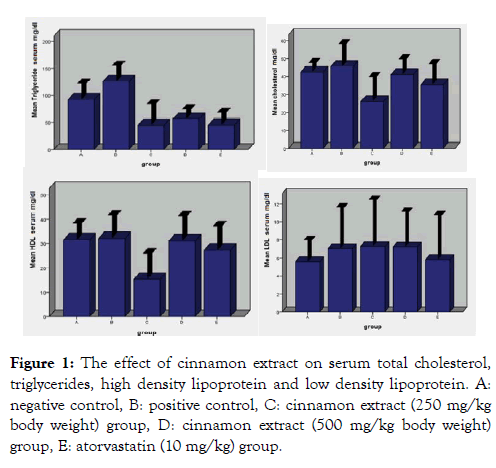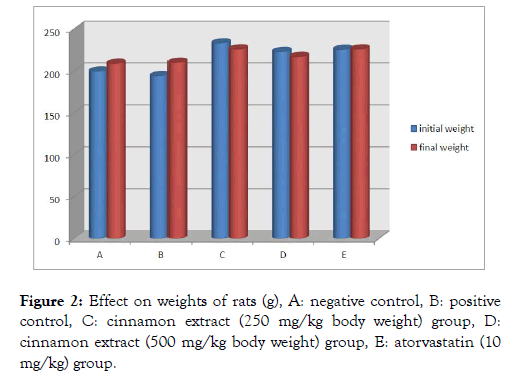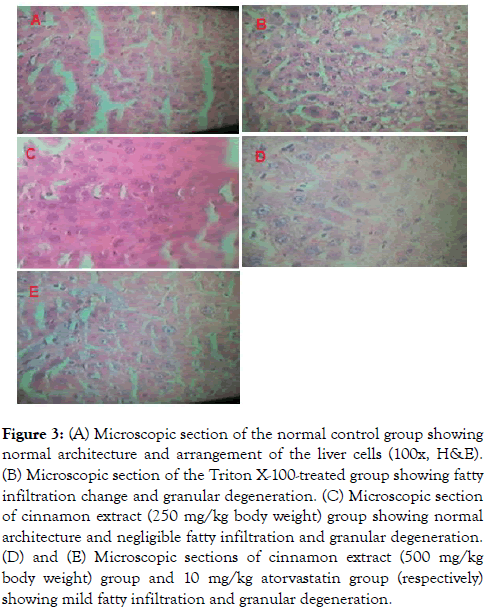Medicinal & Aromatic Plants
Open Access
ISSN: 2167-0412
ISSN: 2167-0412
Research Article - (2020)Volume 9, Issue 3
Hyperlipidemia is the greatest risk factors that precipitate coronary heart disease. Medicinal may confer hypolipidemic effects in order to compliment the cardiovascular diseases treatment regimen. The aim of this study was to investigate hypolipidemic effect of cinnamon bark ethanolic extract in Triton X-100 induced hyperlipidemic in rats. Twenty five adult male albino rats (150-250 g) were randomly divided into five groups: group A stand as negative control, group B stand as positive control, groups C and D received 250 and 500 mg/kg cinnamon extract respectively and group E received atorvastatin 10 mg/kg after of induction of hyperlipidemia by Triton X-100 for seven days. The results was showed a significant (p<0.05) hypolipidemic effect on cholesterol and triglycerides of cinnamon extract in groups administered 250 and 500 mg/kg compared with the negative and positive control group. Also the hepatic histopathological study was showed that the cinnamon ethanol extract has preventive effect from liver fatty infiltration and granular degeneration.
Cinnamon extract; Hypolipidemic; Triton X-100; Albino rats
Blood lipids and lipoproteins abnormalities are preceding risk factor for cardiovascular diseases; hyperlipidemia contributes significantly within the prevalence and severity of atherosclerosis and coronary arteries diseases [1,2]. Hyperlipidemia is especially related to increased serum Total Cholesterol (TC), rarity Lipoprotein (LDL), very rarity lipoprotein (VLDL) and reduced High Density Lipoprotein (HDL) level. The control of normal blood lipids levels, by a drug or diet regimen could reduce the danger of cardiovascular diseases [3]. Ethnopharmcological use of medicinal plants for the management of cardiovascular diseases has increased, especially in developing countries which may encouraged the researchers for exploring novel lipid lowering pharmaceuticals [4].
Plant material cinnamon, one of the most important and popular spices used daily by people worldwide without side effects, is extracted from the inner bark of trees of the genus Cinnamomum of the family Lauraceae [5] that represented by approximately 250 species widely found across Asia, Australia, and South America [6,7]. Cinnamomum zeylanicum is small ever green tree native to India and Sri Lanka, early decades cinnamon bark available only as a wild plant but now entire barks obtained from cultivated plants [8]. Medicinally it was used as antioxidant [9], anti-inflammatory [10], antidiabetic [11], anti-cancer [12] and antimicrobial [13], and traditionally it was used mainly in aroma and essence industry due to its fragrance, as a spice in food stuffs and drinks [14] as well. Cinnamon bark major active constituents are volatile oil (cinnamaldehyde, eugenol, linalool, safrole, pinene, phyllandrene, cymene and cineol), tannins constituting polymeric 5,7,3,4-tetrahydroxy -tetrahydroxy flavan-3-4-diol units, catechins, proanthocyanidins and resins [15].
Many experimental animal models were used for induction of hyperlipidemia, such as Triton X-100 induced hyperlipidemia. Triton X-100 is a non-ionic surfactant which accelerates hepatic cholesterol synthesis and enhances intestinal lipid absorption by the emulsification process. It suppresses the lipoprotein lipase action and blocks the uptake of lipoproteins from circulation by the extrahepatic tissues which resulting in increased blood lipid concentrations [16].
Further studies are necessary to prove the traditional uses of this cinnamon bark as lipid lowering agent and prevention of atherosclerosis. The known active constituents in cinnamon are may improves hyperlipidemia by known mechanisms shown in Table 1. Cinnamon extract may offer a low cost, readily available and relatively easily implemented means of reducing hyperlipidemia.
| Active constituents | Mechanism of action |
|---|---|
| Cinnamate (cinnamic acid) | Inhibiting hepatic-hydroxy β-methylglutaryl-CoA (HMG- CoA) reductase activity [17]. |
| (-)-Epicatechin | Lipid‐lowering effect by stimulation of CYP7A1 at mRNA level and promoter activity [18], also reduces TC, LDL-C and TG levels by regulation of the Insig-1-SREBP-SCAP pathway [19]. |
| Quercetin | Upregulation of SR-BI expression and subsequent lipid (HDL-C) uptake [20] and induces cholesterol efflux Activation of the PPARγ-LXRα pathway to upregulate ABCA1 expression [21]. |
| Geraniol | Decreases serum TC and TG levels by decreased HMGCR protein levels and catalytic activity [22]. |
Table 1: The known active constituents in cinnamon that may improve hyperlipidemia.
Collection of plant material and identification
Cinnamomum zeylanicum bark was purchased from the local market at Khartoum city, Sudan. The studied plant part was identified and authenticated by Medicinal and Aromatic Plants Research Centre, Faculty of Pharmacy, University of Gezira, Wad Medani, Sudan.
Preparation of plant extract Cinnamon bark (983.7 g) was cleaned, then was milled into coarse powder using electrical blender. The powdered plant material was macerated in 70% Ethanol at room temperature for 72 hours with occasional shaking; then filtered using Whatman No. 1 filter paper twice. Filtrate was evaporated using rotatory evaporator at 60°C until dryness to yield a dark brown mass, followed by freeze-drying and was stored until use.
The percentage of yield of extract was calculated according to the following formula:
% Yield = [Weight of extract in g/Weight of plant material in g] × 100
Experimental animals
Twenty five healthy adult male albino rats (150-250 g) were obtained from the animal house of Faculty of Pharmacy, University of Gezira, Wad Medani, Sudan, housed in clean cages in animal house with standard environmental condition (temperature 23-27°C, with light and dark cycles of 10 hours and 14 hours respectively), with standard chow feeding and drinking water.
Induction of hyperlipidemia
Hyperlipidemia was induced in four groups by single intraperitoneal injection of freshly prepared solution of Triton X-100 injection (100 mg/Kg) in physiological saline solution after overnight fasting for 18 hours [23].
Experimental design
Twenty-five healthy adult male albino rats (150-250 g) were randomly divided into five groups’each having five rats. These groups were divided as; Group (A) was administered distilled water (negative control). After 72 hours of Triton X-100 injection to other groups, group (B) was put as positive control. Group (C) was received a daily dose of (250 mg/kg) cinnamon extract. Group (D) was received a daily dose of (500 mg/kg) cinnamon extract. Group (E) was received a daily dose of (10 mg/kg) atorvastatin. All the doses were administered to rats as described once a day for seven days [23,24].
Collection of blood samples
On the day eight, rats were weighed before dissection then the blood samples were collected from the thigh vein into Lithium tubes. The collected samples were centrifuged for 10 min, and then serum obtained from samples were collected and sent for analysis of serum Total Cholesterol (TC), Triglycerides (TG), High Density Lipoprotein (HDL) and Low Density Lipoprotein (LDL) [23,25].
Histopathological study
Histopathological study was conducted after rat scarifying then the livers were weighed and preserved in 10% neutral buffered formalin solution for 24 hours [16]. Then biopsies were taken in 10% normal saline and examined grossly for size and adequacy of sampling. One block was taken from each specimen, placed into a tissue cassette and subjected to routine tissue processing under standard conditions using an automated tissue processor machine then embedded in paraffin. The blocks were constructed with embedded paraffin and sections were cut at 4-6 μm thickness using standard microtome. The sections were counterstained with hematoxylin and eosin stain, Mayer ’ s hematoxylin (H&E) and then mounted on cover slip using DPX (Distyrene, Plasticizer and Xylene) mounting media (Sigma- Aldrich) [26]. The findings of sections were reviewed using light microscope (Olympus Corp., Tokyo, Japan), and results were reported.
Histopathologic evaluation and interpretation of the liver biopsy were obtained [27]. Also the morphological histology (fatty liver) was reported [28].
Data analysis
All the obtained data were expressed as means ± Standard Error of Means (SEM) and analyzed using analysis of variance (ANOVA). Comparisons with the control groups were made using One-way ANOVA. The level of statistical significance was set at p<0.05.
Effect on serum lipid profile
In this study Triton x-100 was chosen for the induction of hyperlipidemia (group B,C,D and E) which as an acute model for induction of hyperlipidemia in rats. As shown in Table 2 and Figure 1, group B (positive control) had a meaningful increase in serum TC, TG, HDL and LDL levels when were measured on day 8th. This was significantly higher (p<0.05) when compared to group A, the negative control rats. Triton X-100 reported to be block the clearance of TG-rich lipoproteins and produces acute hyperlipidemia in animal models and also it enhance serum TG and cholesterol levels as an increase of LDL secretion by the liver, followed by reduction of LDL catabolism [16].

Figure 1: The effect of cinnamon extract on serum total cholesterol, triglycerides, high density lipoprotein and low density lipoprotein. A: negative control, B: positive control, C: cinnamon extract (250 mg/kg body weight) group, D: cinnamon extract (500 mg/kg body weight) group, E: atorvastatin (10 mg/kg) group.
| Groups | TC | TG | HDL | LDL | |
|---|---|---|---|---|---|
| A (negative control) | 42.40 ± 04.98 | 92.60 ± 08.00 | 31.40 ± 06.50 | 5.6 | ± 02.30 |
| B (Triton 100 treated) | 45.60 ± 02.00 | 126.0 ± 07.00 | 32.00 ± 09.20 | 7 | ± 02.50 |
| C (Triton 100 + 250 mg/kg of extract) | 26.00 ± 03.40 | 44.00 ± 08.40 | 15.12 ± 01.34 | 7.25 | ± 01.50 |
| D (Triton 100 + 500 mg/kg of extract) | 41.00 ± 08.30 | 56.00 ± 06.00 | 31.00 ± 09.90 | 7.2 | ± 02.80 |
| E (Triton 100 + 10 mg/kg of atorvastatin) | 35.20 ± 11.00 | 45.00 ± 02.00 | 27.20 ± 09.60 | 5.8 | ± 01.90 |
Table 2: The mean value of total cholesterol, triglycerides, high density lipoprotein and low density lipoprotein.
After extraction cinnamon powder (983.7 g) percentage of yield was 9.9%. This results was indicate that administration of cinnamon extract (250 mg/kg) caused a considerably lowered value of serum TC, TG and HDL levels in group C after compared to the levels in group A (negative control) and group E those were treated with standard drug atorvastatin. Moreover, group D which received 500 mg/kg cinnamon extract had serum TC level significantly lower than serum TC level in negative control group. Such effect was also evidently noted in a previous study where Cinnamomum verum (Syn. C. zeylanicum) aqueous was administered orally to rats with Triton X-100 hyperlipidemia [29]. Rats treated with 250 and 500 mg/kg cinnamon extract had serum LDL level was higher than level in negative control rats.
The hypolipidemic effect of Cinnamomum zeylanicum has been demonstrated in other study, presenting that, the methanol extract was administered orally to rats fed with cholesterol induce-hyperlipidemia despite the high doses (500 and 750 mg/kg) taken by them [30]. Also other species, Cinnamomum cassia, powder 4 g/kg showed significant hypolipidemic effect in hypercholesterolemic albino rats by decreasing serum total cholesterol, triglyceride, and LDL [5].
A study indicate that cinnamate, a phenolic compound found in cinnamon bark extract, improves hyperlipidemia, possibly by playing a direct role in lipid metabolism by inhibiting hepatichydroxy β-methylglutaryl-CoA (HMG-CoA) reductase activity that lowering cholesterol production in the liver and suppression of lipid peroxidation via enhancement of hepatic antioxidant enzyme activities [31,32] and also decreased triglyceride levels may be caused by thelipolytic action of cinnamon [33].
The results of this study indicated that cinnamon extract (250 mg/kg body weight) was exhibit hypolipidemic on rats higher than (500 mg/kg body weight), therefore it was found that botanical extracts may contain many of individual constituents at varying abundance and activity of these extracts can result from mixtures of compounds with synergistic, additive, or antagonistic activity which my affected by concentration, extraction or fractionation process [34]. Therefore, further studies should focus on identifying the major active constituents responsible for hyperlipidemia and also aim to figure out its underlying mechanism.
Effect on liver weight and body weight The mean liver weight gain during experiment to rats treated with Triton X-100 and cinnamon extracts was significantly (P<0.05) lower when compared to liver body weight ratio in positive control rats, which only received Triton X-100. There was no significant difference between the mean liver weight in group C (treated with cinnamon extract at 250 mg/kg) and those of group D (treated with cinnamon extract at 500 mg/kg) after experiment (Table 3). Moreover, there was no significant difference between mean body weight gains during experiment all groups (Figure 2).
| Groups | IW | FW | LW |
|---|---|---|---|
| A (negative control) | 199.6 ± 15.17 | 208.8 ± 23.00 | 3.44 ± 0.37 |
| B (Triton-100 treated) | 194.0 ± 24.80 | 210.0 ± 14.50 | 3.77 ± 0.18 |
| C (Triton 100 + 200 mg/kg of extract) | 233.0 ± 24.00 | 226.0 ± 14.80 | 2.86 ± 0.37 |
| D (Triton 100 + 500 mg/kg of extract) | 223.0 ± 21.30 | 217.0 ± 27.25 | 3.22 ± 0.35 |
| E (Triton 100 + 10 mg/kg of atorvastatin) | 225.6 ± 25.00 | 226.0 ± 13.90 | 3.22 ± 0.60 |
Table 3: The mean value of initial rat weight, final weight and, liver weight.

Figure 2: Effect on weights of rats (g), A: negative control, B: positive control, C: cinnamon extract (250 mg/kg body weight) group, D: cinnamon extract (500 mg/kg body weight) group, E: atorvastatin (10 mg/kg) group.
This results similar to study that used alloxan-diabetic rats model was administered Cinnamomum verum (Syn. C. zeylanicum) aqueous extract aqueous different dosages (200, 400, 600 and 1200 mg/kg) [29].
Effect on histological score
As evident from Figures 3A and 3B, the histopathology of liver in rats fed with Triton X100 (group B) was showed fatty infiltration change and granular degeneration as compared to normal control A which had normal architecture. Triton X-100 hyperlipidemic rats, which simultaneously received cinnamon extract 250 mg/kg was showed negligible fatty infiltration and granular degeneration (Figure 3C). Also Triton X-100 hyperlipidemic rats, which simultaneously received 500 mg/kg and 10 mg/kg atorvastatin were showed that mild fatty infiltration and granular degeneration (Figures 3D and 3E respectively).

Figure 3: (A) Microscopic section of the normal control group showing normal architecture and arrangement of the liver cells (100x, H&E). (B) Microscopic section of the Triton X-100-treated group showing fatty infiltration change and granular degeneration. (C) Microscopic section of cinnamon extract (250 mg/kg body weight) group showing normal architecture and negligible fatty infiltration and granular degeneration. (D) and (E) Microscopic sections of cinnamon extract (500 mg/kg body weight) group and 10 mg/kg atorvastatin group (respectively) showing mild fatty infiltration and granular degeneration.
The overall normal hepatic architecture was maintained. It has been reported by previous findings indicated that Cinnamomum zeylanicum methanol extract (10, 50 and 100 mg/kg) was showed fatty degeneration against carbon tetrachloride (CCl4)-induced liver damage in male Wistar rats [35]. The results of all these histopathological study further support the results of biochemical parameters. Thus, the histopathological studies confirm the antihyperlipidemic effects of Cinnamomum zeylanicum.
In conclusion, the results of this study revealed that Cinnamomum zeylanicum ethano extract has a hypolipidemic effect on hypercholesterolemic albino rats by decreasing serum total cholesterol and triglyceride levels. Cinnamomum zeylanicum may serve a dual purpose in patients with hyperlipidemia as adjuvant treatment. The detail mechanisms underlying the hypolipidemic effect and its cellular mechanism of action need to be elucidated in future studies.
None.
The authors would like to extend their sincere gratitude to Faculty of Pharmacy and Faculty of Medicine, University of Gezira, Sudan for support.
This research did not receive any specific grant from funding agencies in the public, commercial, or not-for-profit sectors.
Citation: Abdelgadir AA, Hassan HM, Eltaher AM, Khnsaa Mohammed GA, Lamya Mohammed AA, Hago TB, et al. (2020) Hypolipidemic Effect of Cinnamon (Cinnamomum zeylanicum) Bark Ethanolic Extract on Triton X-100 induced Hyperlipidemia in Albino Rats. Med Aromat Plants (Los Angeles) 9: 351. doi: 10.35248/2167-0412.20.9.351.
Received: 18-May-2020 Accepted: 28-May-2020 Published: 05-Jun-2020 , DOI: 10.35248/2167-0412.20.9.351
Copyright: © 2020 Abdelgadir AA, et al. This is an open-access article distributed under the terms of the Creative Commons Attribution License, which permits unrestricted use, distribution, and reproduction in any medium, provided the original author and source are credited.